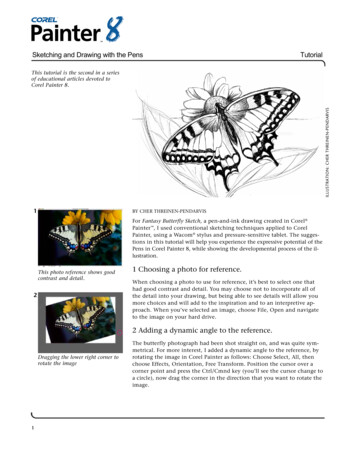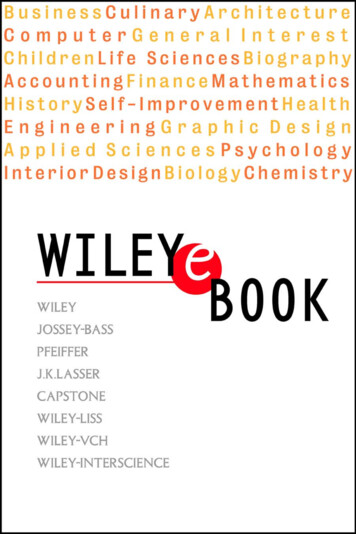
Transcription
Practical Sketching forProduction Systems
Sketching for Production Systems What makes a practical sketch?Sketch-based Architectures Common Questions and Challenges Progression: Experimentation to Data cubesCase StudyImplementation subtlety and challengesAccepting approximationWhich Sketch to use?System planningExamples Apache DataSketches* LibraryDemonstration* Currently in Incubating status
Example: Web Site LogsTimeStampUserIDDeviceIDSiteTime SpentSecItemsViewed9:00 AMU1D1Apps5959:30 AMU2D2Apps1791510:00 AMU3D3Music2931:00 PMU1D4Music8910Billions of Rows or Key, Value Pairs Analyze This Data in Near-Real Time
Exact Analysis Methods Require Local CopiesQuery EngineltDifficuQueryBig DataCol1, ., Item, ., Coln Billions of rows .Local Item CopiesExactResultsΩ(u) size: Big DataQuery processingoften requires sorting which is very slow.Note: Micro-batch “streaming platforms”, e.g., Storm,do not solve the fundamental problem for you!
Parallelization Does Not Help MuchBecause of Non-Additivity.You have to keep the copies somewhere!Example: Map-ReduceCol1, ., Item, ., Coln Billions of rows .CopyCopyCopyCopyCopyCopyExpensive Shuffle𝝨ExactResults
Exact Time WindowingRequires Multiple Touches of Every ItemEvery dataset is processed N times for a rolling N-day window!
Sketch Properties for Production Systems(Not All Sketches Qualify)Small Stored SizeSub-linear in SpaceSingle-pass, “One-Touch”Distribution IndependentOrder IndependentMergeableApproximate, Probabilistic Mathematically Proven Error PropertiesLinearSketch Size Sub-linearStream Size
Sketch-Based Systems Common pattern while exploring sketches Series of design wins from adopting sketches Faster, cheaper, enables new functionality Not all desirable queries have sketching solutionsMay still need to keep raw data
Win 1: Small Query SpaceSketches Start SmallSublinear Means they Stay SmallSingle Pass Simplifies ProcessingQuery EngineCol1, ., Item, ., Coln Billions of rows .ltDifficuQuerySketchApproximateAnswer εO(k) size: KilobytesMinimal orno sorting required!Ideal for Streaming & Batch
Win 2: MergeabilityFull Mergeability Enables ParallelismNon-Additive Metrics Act Like Additive ObjectsFull Mergeability Enables Set Expressions for Selected Sketches , Item many rowsCol1, ., Item, ., Coln Billions of rows .QuerySketchSketch , Item many rowsPartitionsQuerySketchMergeApprox. ε
Win 3: Near Real-Time QueriesWin 4: Simplified ArchitectureIntermediate Hyper-Cube Staging Enables Query SpeedAdditivity Enables Simpler Architecture
Win 5: Time WindowingLate Data Processing Also Simplified
Case Study: Flurry/DruidOffline Online for Near Real-Time ResultsDruid Allows late data updatesStreaming(e.g. Storm)Offline(e.g. Hadoop)Update queries every 15 sec
Case Study: Real-Time Flurry, Before/AfterAlso, Win 6: Lower System Cost Customers: 250K Mobile App Developers Data: 40-50 TB per day Platform: 2 clusters X 80 Nodes 160 Nodes– Node: 24 CPUs, 250GB RAMBig Wins!Near-Real TimeLower System Before SketchesAfter SketchesVirtual CoreSeconds (VCS)per Month 80B 20BResultFreshnessDaily: 2 to 8 hours; Weekly: 3 daysReal-time Unique Counts NotFeasible15 seconds!
Common Questions and Challenges
Implementation is subtle Treat like a math library: Don’t make your ownAlgorithms seem conceptually simple, but Lots of edge cases for robust implementationsFound significant bugs in well-known HLL distributionsSimple mergability alone is insufficient! System design requirements evolve, e.g. target sketch errorNeed correct solutions for merging across sketch sizes
Accepting Approximation Different strategies for different rolesScientists/Engineers Experiment to determine accuracy, see what else sketches provideHow does sketch error compare to other uncontrolled sources of error(e.g. missing/corrupt data or sampling error, whether implicit or explicit)Product Owners Demonstrate new featuresSpeed gains and cost savings (including reprocessing)Note configurable accuracy
Which Sketch Should I use? If multiple sketches seem appropriate, no general answer Accuracy, in-memory size, stored size, update vs merge vs (de)serialize speedMust decide in a systems contextExamples Network Router: Count distinct IPs to detect DDoS attack Want small in-memory size, mergeability and set operations less criticalWeb/App Analytics: Count distinct devices/people visiting Different time windows and set operations likely key features
HLL vs CPC vs Theta HLL CPC (Compressed Probabilistic Counting) Small serialized size, small in-memory footprintModerate merge speedTerrible accuracy for intersections, no set differenceBest known compressed size/accuracy combinationSmallest serialized size, moderate in-memory footprintModerate merge speedTerrible accuracy for intersections, no set differenceTheta Larger serialized size, in-memory footprintFast merge speedBest accuracy for intersections, allows set differencesRelative size increase vs HLL or CPC depends on usage scenario
System Planning: Key Questions What types of queries do I need to support?What accuracy do I really need? Ideally, pick library that lets you change your mind later!Do I need to support real-time data? Late data?With sketches available, what new functions will I want?
Examples
Examples Powered By:Currently in incubation statusdatasketches.apache.org
Who are we?Project Committers Lee Rhodes, Distinguished Architect, Verizon Media (project founder)Alex Saydakov, Systems Developer, Verizon MediaJon Malkin, Ph.D., Research Engineer, Verizon MediaEdo Liberty, Ph.D., Founder, HyperCube TechnologiesJustin Thaler, Ph.D., Assistant Professor, Georgetown University, Computer ScienceRoman Leventov, Systems Developer for Druid, MetamarketsEshcar Hillel, Ph.D., Sr Scientist, Verizon Media IsraelExtended Team/Consultants Graham Cormode, Ph.D., Professor, University of Warwick, Computer ScienceJelani Nelson, Ph.D., Professor, U.C. BerkeleyDaniel Ting, Ph.D., Sr Scientist, Tableau / SalesforceDave Cromberge, Permutivedatasketches.apache.org
About the libraryMission: Deep science quality engineering for Production Quality sketches Trustworthy sketches Robust implementations (8 years of production use) Robust algorithms (see slide 7) Open source characterization codeNotable features for large-scale systems Backwards compatibility Merging across sketch sizes Binary compatibility across supported languages Consistent serialization formatsdatasketches.apache.org
The Apache DataSketches LibraryCardinality, 4 Families HLL: A very high performing implementation of this well-known sketchCPC: The best accuracy per spaceTheta Sketches: Set Expressions (e.g., Union, Intersection, Difference), on/off HeapTuple Sketches: Generic, Associative Theta Sketches, multiple derived sketches:Quantiles Sketches, 2 Families Quantiles, Histograms, PMF’s and CDF’s of streams of comparable objects, on/off Heap.KLL, highly optimized for accuracy-space. Relative Error Quantiles (under development)Languages Supported: Java, C , Python Binary CompatibilityFrequent Items (Heavy-Hitters) Sketches, 2 Families Frequent Items: Weighted or Unweighted Frequent Directions: Approximate SVD (a Vector Sketch)Sampling: Reservoir and Variance Optimal (VarOpt) Sketches, 2 Families Uniform and weighted sampling to fixed-k sized bucketsdatasketches.apache.org
Thank you!
Sketching for Production Systems * Currently in Incubating status What makes a practical sketch? Sketch-based Architectures Progression: Experimentation to Data cubes Case Study Common Questions and Challenges Implementation subtlety and challenges Accepting approximation Which Sketch to use? System planning Examples










